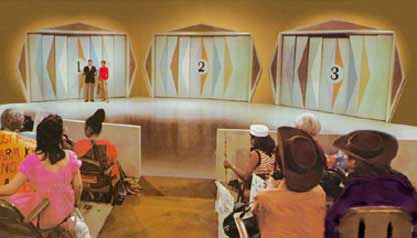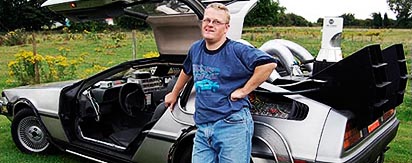The Monty Hall Problem
The Monty Hall Problem is probably the most famous example of how the math of uncertainty can be unintuitive and rather surprising.
Time to use a bit of imagination.
You are a contestant on the game show “Lets Make a Deal” and the host, Monty Hall, presents you with the following scenario:
There are three closed doors up on the stage. One door is hiding shiny new car. All three doors look exactly the same and you have no idea where the car is.
You want that car. You NEED that car.
Monty instructs you to pick one door. After much deliberation you decide door #1.

The game continues:
 Monty: “Now, before we open door #1, lets see what’s behind door #3!”
Monty: “Now, before we open door #1, lets see what’s behind door #3!”
No car. A goat..Interesting.
Now there are two remaining unopened doors, #1 and #2. You know one of them is hiding a car.
The game continues:
Monty: “Do you want to stick with door #1 or switch to door #2?”
Tough choice!
You think: “Should I switch doors? Should I stay? With 2 doors left does it even matter what I do?”
It is common to think that the probability the car is behind either of the remaining doors is one-half you have an equally likely chance of winning no matter what.
The surprising truth is that the preceding thought process is completely wrong. The reality is, loosely speaking, you are twice as likely to win if you switch doors. WTF?
Here’s why:
Before you decide to stay or switch, Monty always reveals a door that does not have the car. This is extremely valuable information!
To see why, think about the beginning of the game and your first choice of doors.
You have a one-third chance of picking the winning door with your initial choice. If this happens and you switch doors, you will end up with a losing door. This is relatively obvious.
Similarly, your chance of picking the wrong door initially is two-thirds. Here, if you switch doors, you will always end up with you winning the car. This fact is subtle and key to understanding this problem.
Remember how we said Monty revealing a losing door was important? If you started with the wrong door, and Monty revealed the other wrong door, then only unopened door left is the one with the car!
What this means is if your original pick was wrong and you then switch to the remaining unopened door, you are guaranteed to win.
It might be helpful to draw a crude picture of 3 doors and see what I am talking about visually.
Since, you are twice as likely to pick a losing door initially, you are twice as likely to win if your strategy is to always switch doors.

Does switching doors guarantee you will win? Unfortunately, no. For an individual game the outcome is always uncertain. In the middle of the game you never know if your initial pick was right or not and there is no way to change this. (bribery?)
The mathematical interpretation of you are “twice as likely to win” means that if you played this game many many many times and switched doors every time, you would win about twice as many games as you would if you played those games and never switched.
The challenging nature of this problem lies in the often unintuitive realm known as conditional probability.
The question is not “What is the probability that I win if I switch doors?”
The exact question is “What is the probability that I will win given that Monty helped me out tremendously by revealing a losing door?”.
Two-thirds! Always switch!
(Don’t get mad at math if you switch doors and end up losing. For that you can thank randomness and uncertainty.)
For more insight on this problem, check out Wikipedia.
**I have rewritten the original post following the idea I originally wrote in this comment. Thanks Jake for helping me see my original expliation really didn’t make any sense. It wasn’t you**
That was a good example. I have re-read it many times, and it makes sense, but still a little over my head. I just have one question…Will you come to Vegas with me???
Thanks for the comment Jake. I think it is a really interesting problem and one that is not at all intuitive.
You inspired me to re-write much of the explanation. I didn’t do a very good job before. Hopefully this is a little better.
Second explanation above is a winner!